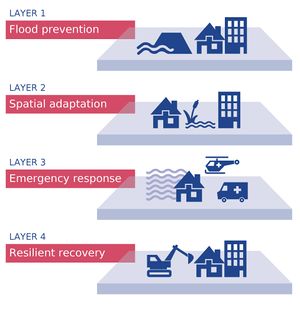Layer 2- Spatial adaptation
What is layer 2?
Layer 2 of the Multi-Layered safety concept is the layer of spatial adaptation and refers to removal of measures or relocation of construction in flood prone areas and appropriate land use (flood risk modeling, assessment, flood risk zoning).
Layer 2 in the MLS concept
By using the Multilayered Safety (MLS) concept, different types of flood management measures are integrated, resulting in an overall reduction of the probability and the consequences of floods. MLS consists of four layers. Prevention is the first layer of MLS. The second and third layers are consequence-reducing measures, namely spatial solutions (layer 2) and emergency response (layer 3). Layer 1 and layer 2 are physical measures, whereas the third and fourth layers, crisis management and recovery, concentrates on organizational measures.Together, these layers can be tailored to local areas in order to minimize flood damage.
What measures were taken in the FRAMES pilots in this layer?
There are many measures that can be taken in this layer. The FRAMES pilots that took measures linked this layer related to:
- Natural Flood Management or NFM, considers the hydrological processes across the whole catchment of a river or along a stretch of coast to identify where measures can best be applied, with a focus on increasing water retention capacities (EU, 2019). Examples of such measures are:
- Restoring natural flows by realignment of coastal areas, or re-connection of rivers with their floodplain.
- Restoration of wetlands which can store flood water and help “slow the flow” of flood waters.
- Reservoirs in agricultural areas which can store flood water during flood events, and otherwise be high nature value areas.
- Urban Green Infrastructure such as green spaces, sustainable urban drainage and green roofs."
- Flood proof design and planning measures are preventive measures taken to reduce consequences and damage of flood events by keeping water away from people and flood prone areas. Preventive measures require proactive spatial planning and flood-proof spatial design. Proactive spatial planning refers to removal of measures or relocation of construction in flood prone areas and appropriate land use (flood risk modeling, assessment, flood risk zoning). Flood-proof spatial design implies the adaptation of existing and future constructions (adjustments of existing houses and infrastructure).
- Critical infrastructure is the physical and information technology facilities, networks, services and assets that, if disrupted or destroyed, would have a serious impact on the health, safety, security or economic well-being of citizens or the effective functioning of governments in EU States. Critical infrastructures extend across many sectors of the economy, including banking and finance, transport and distribution, energy, utilities, health, food supply and communications, as well as key government services (COM, 2004).
What tools were used in the FRAMES pilots in this layer?
FRAMES has compiled a list of tools used in the pilots and classified these per layer. Click here to find out what tools are available for layer 2.
Referenties
- EU Critical Infrastructure Protection in the fight against terrorism, European Commission, EU, 20 oktober 2004.
- Towards better environmental options in flood risk management, European Union, European Union, 8 juli 2019.
Hier wordt aan gewerkt of naar verwezen door: Adaptive planning, Community resilience, Critical infrastructure, Layer 2- Spatial adaptation, Natural flood management, Natural flood management, Preparedness and emergency planning


